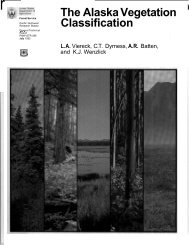Lecture 3: Vegetation Sampling - Alaska Geobotany Center
Lecture 3: Vegetation Sampling - Alaska Geobotany Center
Lecture 3: Vegetation Sampling - Alaska Geobotany Center
You also want an ePaper? Increase the reach of your titles
YUMPU automatically turns print PDFs into web optimized ePapers that Google loves.
Soils <br />
• The soil-‐vegeta@on rela@onships are a key to understanding <br />
vegeta@on paXerns. <br />
• If you have a background in soils, then it is desirable to obtain <br />
as complete soil informa@on from each sample site as <br />
possible. Or work in conjuc@on with a soil scien@st. <br />
• The effort should include digging a soil pit, making a quick <br />
descrip@on of the soil (see relevé soil form), and collec@ng soil <br />
from each soil horizon for later analysis. <br />
• Use a can of known volume to carefully collect the soil. At a <br />
minimum, a grab sample (large handful) of soil should be <br />
obtained from the top mineral horizon (generally 10 cm <br />
depth). This can later be analyzed for pH, percent soil <br />
moisture, soil texture, soil color, percent organic maXer, soil <br />
nutrients (N, P, K) and other physical and chemical <br />
characteris@cs. <br />
• In our class sampling, we use a simplified soil descrip=on that <br />
is part of the site factor data sheet, and we will collect soil <br />
samples from the roo=ng zone (about 10 cm) or the top of the <br />
first mineral horizon in organic-‐rich (peaty) soils.
















